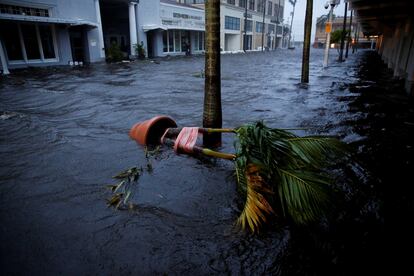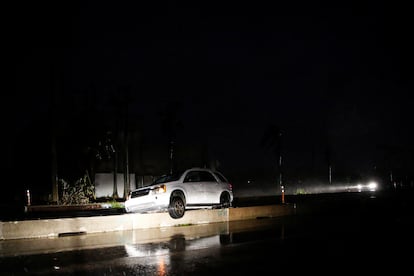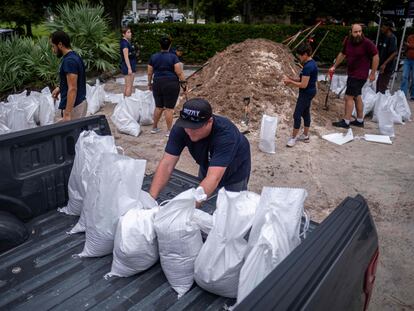Hurricane Ian leaves trail of destruction in Florida
The storm has been downgraded to a Category 1 due to plunging wind speeds, but could still inflict damage as it heads for Georgia and South Carolina

Hurricane Ian left a trail of severe damage as it cut northeast across Florida on Thursday and reached the Atlantic, where it was expected to head north towards Georgia and South Carolina. Streets and homes were flooded, emergency services overwhelmed and millions of customers were without power as Ian battered the southwest coast of the peninsula with torrential rains and sustained winds of about 150 mph.
Authorities in Volusia County confirmed on Thursday the death of a 72-year-old man, who drowned overnight after leaving his home to drain his pool.
President Joe Biden declared a major disaster, releasing federal funds to help with the recovery as requested by Florida Governor Ron DeSantis. “The impacts of this storm are historic and the damage that has been done is historic,” said DeSantis in a televised update at 8.45am local time. “There’s going to be a lot more [damage] asessing in the days ahead but I think we’ve never seen a flood event like this, or a storm surge of this magnitude.”
Entire areas in cities such as Naples and Fort Myers were flooded following storm surges described as “catastrophic” by the US National Hurricane Center (NHC). Nearly 2.6 million customers were without electricity across the state, according to the monitoring site poweroutage.us, and emergency workers in the southwest were having trouble responding to all the calls due to street flooding and road debris.
After ravaging western Cuba a day earlier, Ian made landfall near Fort Myers at around 3pm on Wednesday as a Category 4 storm, but has since been downgraded to Category 1 after maximum sustained winds decreased to around 75 mph. Despite reduced wind speeds, the storm continued to dump flooding rains across central and northern Florida on its way to the eastern coast.
Monstrous and historic

Hurricane Ian was described as “monstrous” and “historic” by expert meteorologists on Wednesday, when it made landfall on the western coast of the Florida peninsula. By late Wednesday, storm surges of up 12 feet (3.6 meters) had been reported along 200 kilometers of coastline between the cities of Naples and Sarasota.
Television images showed how the storm surge had inundated coastal areas of Naples, well south of the path of the hurricane’s eye, as well as in Fort Myers. There were other implausible scenes showing how the waters off the beaches of Tampa and Sanibel Island had suddenly receded, sucked into Ian’s rotation and leaving the seabed exposed.
Over 600 flights, including 50 connections to Cuba, were canceled at the international airports in Miami and Fort Lauderdale, while Tampa International Airport remained closed since Tuesday night.
There was still no precise information about human loss late on Wednesday, although the Coast Guard announced a search operation for a boat with 20 Cuban immigrants on board that reportedly capsized near Key West. The incident was reported by four survivors who swam to Stock Island.

Although Ian has been downgraded to a tropical storm, it retains enormous potential for destruction. The Miami Herald noted that just its eye could fit the total area of Hurricane Charley, a Category 4 hurricane that hit the west coast of Florida in 2004. The newspaper also noted that “Ian has already brought record-breaking storm surge highs for Key West, Fort Myers and Naples several feet above previous high water marks.”
Although forecasters had warned for days that the cyclone would affect the string of beach suburbs and cities along the Florida coast on the Gulf of Mexico, Ian moved slightly east at the last minute, averting a catastrophe for the cities of Tampa Bay, a densely populated area.
According to various media outlets, Ian has already become the fifth most powerful hurricane in US history and the third most powerful in Florida, after Andrew (1992) and Wilma (2005). In 1992 Andrew destroyed nearly 100,000 homes and killed 65 people in southeast Miami. On this occasion, Miami was spared the worst of the storm although at least six tornadoes were reported in northern Miami-Dade County and in neighboring Broward County between Tuesday and Wednesday.
Tu suscripción se está usando en otro dispositivo
¿Quieres añadir otro usuario a tu suscripción?
Si continúas leyendo en este dispositivo, no se podrá leer en el otro.
FlechaTu suscripción se está usando en otro dispositivo y solo puedes acceder a EL PAÍS desde un dispositivo a la vez.
Si quieres compartir tu cuenta, cambia tu suscripción a la modalidad Premium, así podrás añadir otro usuario. Cada uno accederá con su propia cuenta de email, lo que os permitirá personalizar vuestra experiencia en EL PAÍS.
¿Tienes una suscripción de empresa? Accede aquí para contratar más cuentas.
En el caso de no saber quién está usando tu cuenta, te recomendamos cambiar tu contraseña aquí.
Si decides continuar compartiendo tu cuenta, este mensaje se mostrará en tu dispositivo y en el de la otra persona que está usando tu cuenta de forma indefinida, afectando a tu experiencia de lectura. Puedes consultar aquí los términos y condiciones de la suscripción digital.
More information
Archived In
Últimas noticias
Most viewed
- Sinaloa Cartel war is taking its toll on Los Chapitos
- Oona Chaplin: ‘I told James Cameron that I was living in a treehouse and starting a permaculture project with a friend’
- Reinhard Genzel, Nobel laureate in physics: ‘One-minute videos will never give you the truth’
- Why the price of coffee has skyrocketed: from Brazilian plantations to specialty coffee houses
- Silver prices are going crazy: This is what’s fueling the rally









































